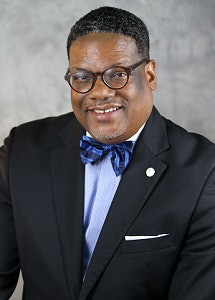The landscape of education has changed greatly in the last 10 years. In the wake of soaring college costs, falling state support, a decrease in high school graduates and an unstable economy, college enrollment is down across the board. HBCU enrollment is no exception.
According to the National Center for Educational Statistics, between 1976 and 2010, the number of HBCU students increased 47 percent, from 223,000 to 327,000 students; however, since then, there has been a decrease of 11 percent, to 292,000 students. This decline in enrollment is a call of action to attract a more diverse student body. It is common knowledge that HBCUs have been successful in preserving, teaching, and maintaining the historical significance of its institution; however, it can no longer be denied that the future of HBCUs is closely relative to our ability to appeal to the masses.
 Dr. Marcus A. Chanay
Dr. Marcus A. ChanayWhen weighing in on the feasibility of diversity, it must be realized as the discussion of diversity these days doesn’t center exclusively on race. Rather, the context is more relative to the ability to cater to on-and-off campus attendees, to be flexible enough for returning adult students, rigid enough for first-timers, and offering various degree programs and certifications as well. The more viable options available, the wider the net these institutions can cast to attract a variety of students. Redefining what and who the ideal student is, is an excellent place to address diversity to establish a discourse about how a college education can be repackaged to attract and benefit those who fall outside of what is considered the average college student. Institutions of education today must take it upon themselves to provide relevant education opportunities for today’s learner, which means reaching students who need flexible, non-conventional education solutions.
Some HBCUs are infamous for being predominately White. Namely, Bluefield State College and West Virginia State University, both located in West Virginia, both have relatively low percentage of black enrolled students. Given the landscape of West Virginia — Blacks represent a mere 3.6 percent in the state, the demographics are perfectly justified. This only proves the viability of HBCUs to thrive, even in non-Black suburban settings. For HBCUs seeking to embrace and attract other races and ethnicities, they may want to replicate the blueprint of Bluefield State College. Formerly known as Bluefield Colored Institute, the school was opened in the late 1800s to accommodate the children of coal miners who had relocated to segregated West Virginia embarking on mining careers. Today, the school boasts a White enrollment of almost 90 percent. Universities can establish interconnectivity within urban and suburban communities as well as cross-cultural events to help drive up enrollment. Creating clubs or programs that are based on merit or perhaps another non-racial identifier, like Minorities in Medicine or National Novel Writing Month activities, can help unite across racial divides while simultaneously encouraging students to hone in on specific skill sets.
 Dr. Adriel A. Hilton
Dr. Adriel A. HiltonAnother tactic to promote diversity is to appeal to ethnicities that are heavily concentrated in certain geographical areas across the country. For example, Lincoln University of Missouri has attracted 42 percent of White students and Jarvis Christian College is another HBCU that has been relatively successful at attracting a Hispanic population, with just under 10 percent of their population being Hispanic. Word of mouth traveling through a specific ethnic community is indeed one vehicle of spreading the word about the potential benefits of enrolling at a HBCU. Also, within certain ethnic communities, there may be great diversity; however, while some may desire to see faces like their own, another tactic would be attracting potential students to already-enrolled students who share similar talents, interests or skill sets. Using this approach can help HBCUs create diversity initiatives and marketing materials that can engage a wider range of students.
The options are limitless to continue a successful effort to expand diversity throughout HBCUs. Though the face of HBCUs may look different from what it did maybe 50 years ago, the very principles and foundation these institutions were founded upon have not changed. There is indeed a great opportunity for HBCUs to establish renewed relevance by restructuring our programs, departments, technology and our offered services to meet the ever-evolving needs of college students today. Today’s college student includes everyone from single parents, to professionals already working in their career field, to those slowly working their way through college at multiple part-time jobs, online classes, programs providing paid internships and independent studies. Creating more initiatives to tracking and contacting HBCU alumni can further help stimulate future diversity efforts as well since inter-race, religious and cultural partners have become more commonplace.
Dr. Marcus A. Chanay is vice president for Student Affairs & Enrollment Management at Lincoln University of Missouri. Dr. Adriel A. Hilton is dean of students and diversity officer at Seton Hill University.















